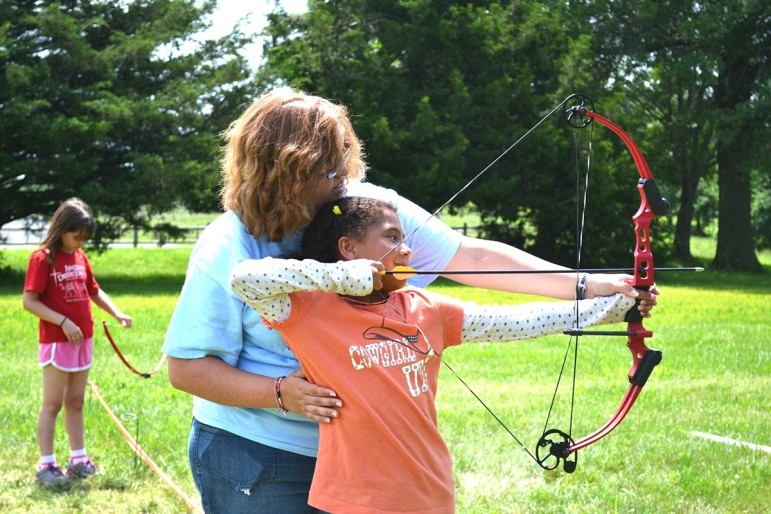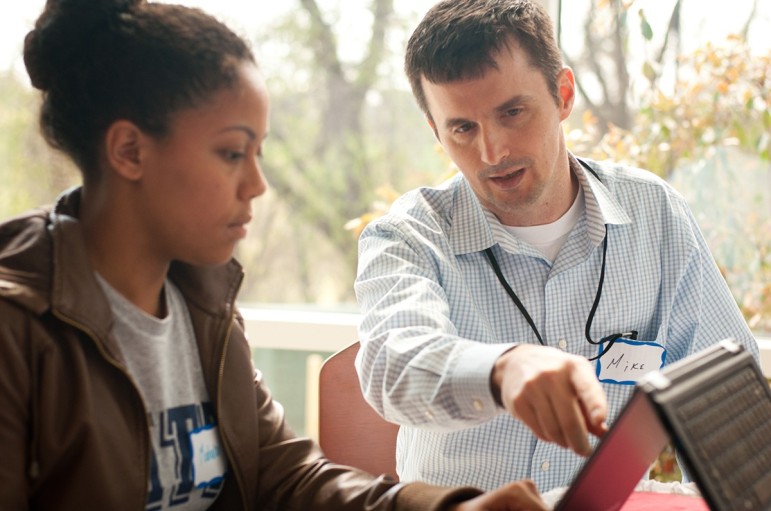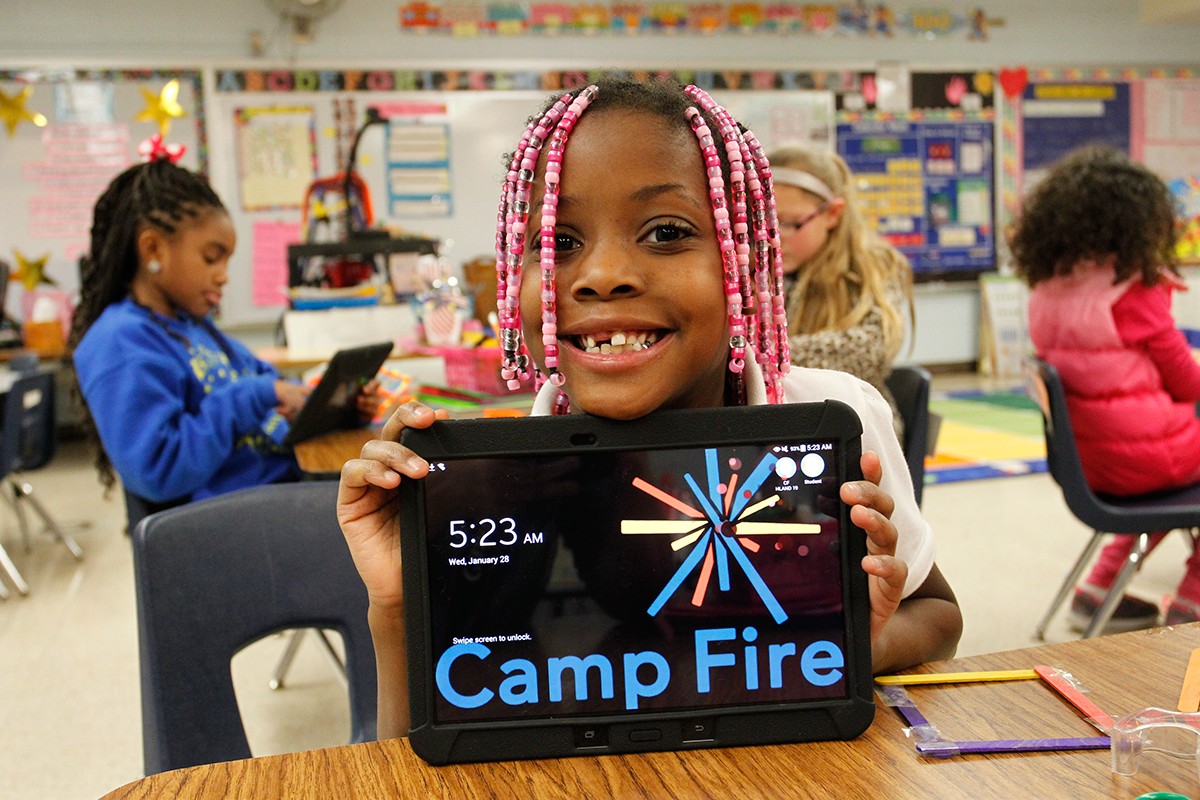Kids in Camp Fire Long Beach — a branch of the national Camp Fire youth organization — worked busily in an art workshop this past spring, creating art to illustrate the activities they most enjoyed. They painted, took photos and otherwise created images of their passions.
Then they were asked to list adults who were their “spark champions,” adults who had supported them in these interests. These adults were later recognized in a ceremony.
It was one step of a carefully designed approach to help kids thrive — known in Camp Fire as Thriveology.
The 105-year-old organization has thrown itself into a program first rolled out by the Thrive Foundation for Youth.
Camp Fire serves about 1 million children, teens and families, according to the organization, with traditional camp experiences and outdoor programs, partnerships with schools for out-of-school time programs, and service learning for teens.
Now, fresh from an evaluation of Thriveology, Camp Fire is expanding this program to its 58 councils around the nation.
Staff members seem highly enthusiastic.
“I really think Thriveology is a game changer for youth-development work,” said Georgia Stewart, associate executive director of Camp Fire Long Beach (Calif.)
The approach involves adult mentors working with kids in four areas:
- Identify and develop interests and passions.
- Adopt a growth mindset — an attitude of possibility — by learning about the brain’s ability to grow and change.
- Reflect on 12 indicators of thriving and decide which to pursue. (These include love of learning, healthy habits, emotional competence, social skills, positive relationships, spiritual growth and more.)
- Develop goals and the skills to pursue them.
This approach came from the Thrive Foundation’s mission to help disadvantaged youth live up to their full potential. The Menlo Park, Calif.-based foundation was created in 2000 by a Silicon Valley executive and his wife. In its first years, the foundation funded research into what enables kids to thrive, said Peter Samuelson, the foundation’s director of research and evaluation and a former Lutheran minister. Thriving is “a forward, purposeful motion towards achieving one’s full potential,” according to the foundation.
The Thrive Foundation supported researcher William Damon’s exploration of purpose in the lives of young people, including how kids find a sense of purpose, and Peter Benson’s work on helping young people develop their strengths.
It also supported Richard Lerner’s research on self-regulation and the work of Carol Dweck and David Yearger on mindsets and how they affect young people.
“A growth mindset says you can work hard to develop talent and intellect,” Samuelson said. A fixed mindset says you can’t really improve those abilities.
(Dweck’s book “Mindset: The New Psychology of Success,” was on the National Afterschool Association’s summer reading list this summer.}
“These four areas were researched heavily by the foundation,” Samuelson said.
By 2008, the foundation had produced a curriculum it called Step-It-Up-2-Thrive.
“Each of those areas is a facet of positive youth development,” Samuelson said.
But the driver of it all is the idea of purpose.
“If you can help a young person find a purpose or spark that really interests them, then these other things come along,” he said.

Camp Fire
Camp Fire, which offers outdoor activities, after-school programs and teen leadership opportunities, weaves a new approach known as Thriveology throughout its activities.
Connecting kids with concepts
Stewart, of Camp Fire Long Beach, has often sat in a circle with a new group of kids and played an icebreaker that helps kids learn each other’s names. They throw a ball around the circle and each person catching it repeats the names that have been said before.
These days, Stewart uses the activity to introduce a Thriveology concept.
“When you ‘thrive’ [the game], you start talking about how the brain works,” she said.
The movement of the ball mimics the way thought jumps between synapses in the brain, she tells the kids.
You learn by practice, she tell them. The more you toss the ball, the faster you get.
“You just start to come up with techniques and tips that will make you better,” she said.
“It reminds people that practice makes perfect,” she said.
[module type=”aside” align=”right”]Evaluating Thriveology’s impact
In December 2014, Camp Fire surveyed young people in its programs across the nation to evaluate Thriveology.
- 82 percent stated adults in Camp Fire helped them solve problems instead of telling them what to do.
- 83 percent said if they did not achieve their goal on the first try, they would not give up.
- 84 percent reported they were taught they could figure things out even when they did not know the answers.
- 82 percent reported that at Camp Fire they learned they did not have to be born with talent in order to be good at something.
Source: Camp Fire
[/module]James Martinson, director of program methods and standards at Camp Fire, said the organization’s staff members encourage a growth mindset in many ways, including how they give out praise, how they provide challenges and the opportunities to build skills.
The idea of a growth mindset is that “intelligence and ability can grow over time,” he said. It’s a simple idea that has deep implications, he said.
Dweck’s research showed that young people with a growth mindset were better able to face challenges and thrive.
Camp Fire Long Beach also adds a twist to a tried and true team-building activity known as Walking Ski. Two planks are laid on the ground. A small group stands in a line, with each person placing his or her left foot on the left plank and right foot on the right plank. Each holds a rope connected to the planks. The goal is to lift the ropes and feet in unison to move the “ski” forward or backward.
[Related: Why Should Cities Invest in After-school Programs? Five Mayors Explain]
When the group does this, Stewart talks about moving forward and moving backward in their lives. She lists some of the indicators of well-being for young people and some of the risk factors. As she does, the group moves forward or backward depending on their opinion about each factor.
How well can you walk forward if you are using alcohol, for example, she asks.
“That really seemed to communicate itself to kids,” she said.
“Most of the people who do it come away with a moment of intuition about it that they can apply in their own life,” she said.
Reflection is a key component of Thriveology, Martinson said. Kids reflect upon their spark, the progress they have made, why it is meaningful to them and what they might want to do with it in the future. They also look at their mindset and examine how they deal with challenges and failure.

Camp Fire
Reflection is a key component of Thriveology.
Goal management is summed up in the acronym GPS. G refers to finding meaningful goals, P refers to making plans around pursuing the goal, and S is about shifting gears productively in pursuit of the goal as circumstances change.
Goal management is the ongoing and dynamic approach of being able to shift and change as the path changes, Martinson said.
Adopting and adapting
Camp Fire has been very successful in adapting the ideas of Thriveology to their setting and organization, said Samuelson of the Thrive Foundation.
“They made it their own,” he said.
The Thrive Foundation provided grants to eight youth-serving organizations in 2012, giving a total of $2.4 million to them to put the research on thriving into practice.
Camp Fire received $1.6 million and began training staff in 10 of its 58 councils. It also received a grant of $1 million from New York Life for the same program development. By summer 2012, Camp Fire was using the Thriveology approach with kids ages 11 to 17.
Since then, however, the Thrive Foundation has shifted course.
“It wasn’t quite the direction the foundation wanted to go,” Samuelson said.
“We found that a caring adult/youth relationship was at the heart — especially with disadvantaged youth,” he said.
“We’re going to look at various ways caring adults engage with youth,” he said.
The basic ideas of thriving are still relevant, he said. “There’s a continuity in our thought.
“But the tool may not matter as much as the caring adult,” Samuelson said.
Camp Fire, however, is going full steam ahead with Thriveology. Thirty councils have implemented the approach so far, and all staff who join the organization receive an orientation in it.
Thriveology is not a curriculum, Martinson said. It is an approach that can be used by Camp Fire staff as it works with kids in numerous settings and activities.
It enhances the core values of Camp Fire, he said.
More stories related to this one:
Youth Document Their Communities Through Photo Essays
After-school Programs Step Forward to Align With Common Core
An Underdog Sport in NY, Wrestling Helps Students Score Better Grades
Music Program Helps Homeless, Runaway Youth Follow their Dreams































